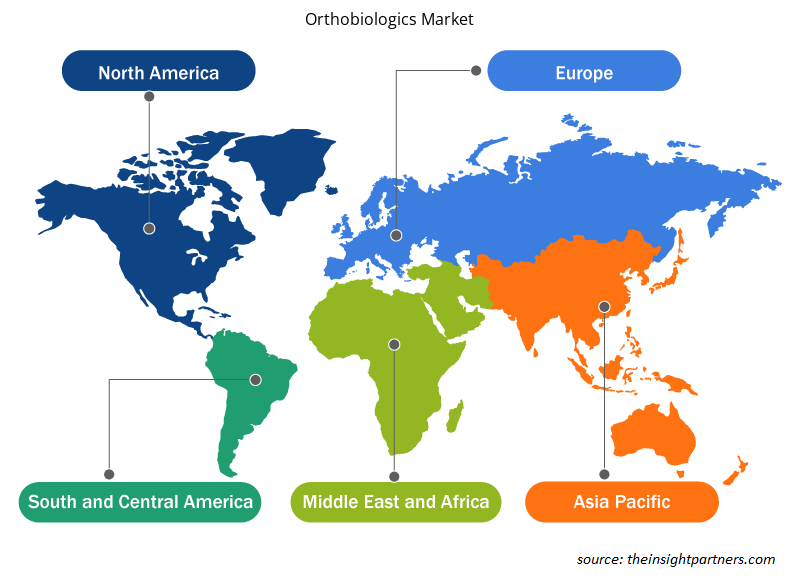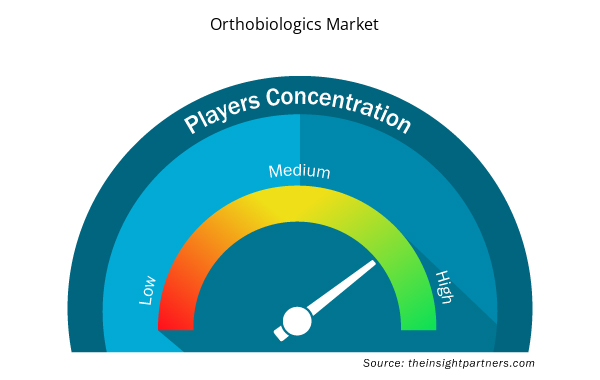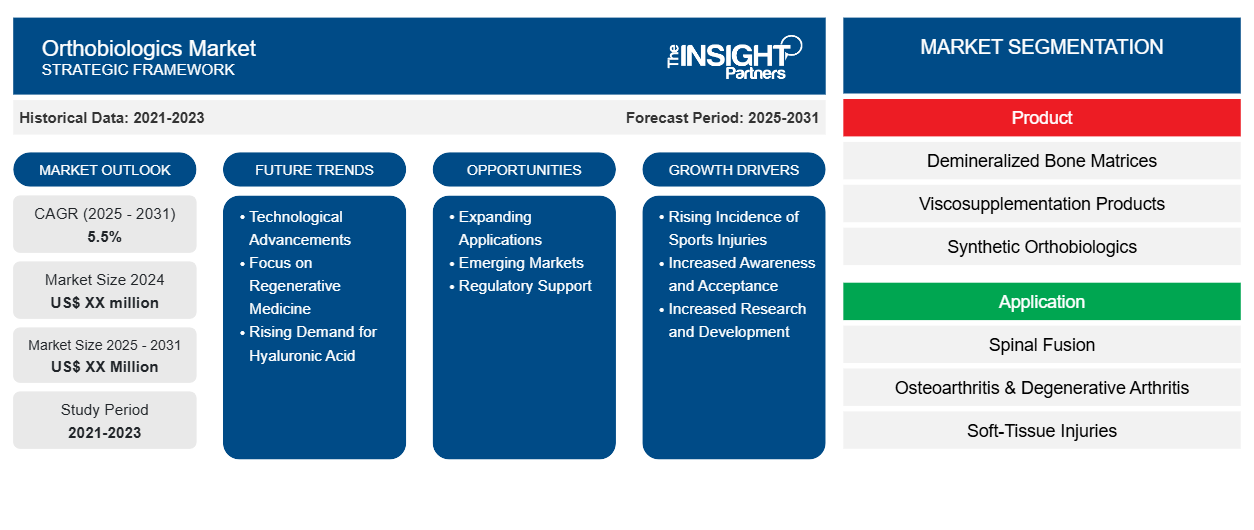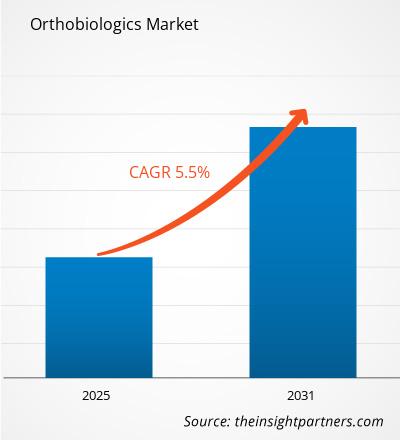Le marché des produits orthobiologiques devrait enregistrer un TCAC de 5,5 % de 2023 à 2031, avec une taille de marché passant de XX millions USD en 2023 à XX millions USD d'ici 2031.
Le rapport est segmenté en produits ( matrices osseuses déminéralisées , produits de viscosupplémentation , produits orthobiologiques synthétiques , allogreffes , protéines morphogéniques osseuses et autres) ; applications (fusion vertébrale, arthrose et arthrite dégénérative, lésions des tissus mous, récupération après fracture et autres) ; utilisateurs finaux (hôpitaux, cliniques orthopédiques, centres de soins ambulatoires et autres utilisateurs finaux). L'analyse globale est ensuite décomposée au niveau régional et par principaux pays. Le rapport offre la valeur en USD pour l'analyse et les segments ci-dessus.
Objectif du rapport
Le rapport sur le marché des produits orthobiologiques de The Insight Partners vise à décrire le paysage actuel et la croissance future, les principaux facteurs moteurs, les défis et les opportunités. Cela fournira des informations à diverses parties prenantes commerciales, telles que :
- Fournisseurs/fabricants de technologie : pour comprendre l’évolution de la dynamique du marché et connaître les opportunités de croissance potentielles, leur permettant de prendre des décisions stratégiques éclairées.
- Investisseurs : Effectuer une analyse complète des tendances concernant le taux de croissance du marché, les projections financières du marché et les opportunités qui existent tout au long de la chaîne de valeur.
- Organismes de réglementation : Réglementer les politiques et surveiller les activités du marché dans le but de minimiser les abus, de préserver la confiance des investisseurs et de maintenir l’intégrité et la stabilité du marché.
Segmentation du marché des produits orthobiologiques
Produit
- Matrices osseuses déminéralisées
- Produits de viscosupplémentation
- Produits orthobiologiques synthétiques
- Allogreffes
- Protéine morphogénique osseuse et autres
Application
- Fusion vertébrale
- Arthrose et arthrite dégénérative
- Blessures des tissus mous
- Récupération après fracture et autres
Utilisateur final
- Hôpitaux
- Cliniques orthopédiques
- Centres de soins ambulatoires et autres utilisateurs finaux
Géographie
- Amérique du Nord
- Europe
- Asie-Pacifique
- Amérique du Sud et Amérique centrale
- Moyen-Orient et Afrique
Géographie
- Amérique du Nord
- Europe
- Asie-Pacifique
- Amérique du Sud et Amérique centrale
- Moyen-Orient et Afrique
Personnalisez ce rapport en fonction de vos besoins
Vous bénéficierez d'une personnalisation gratuite de n'importe quel rapport, y compris de certaines parties de ce rapport, d'une analyse au niveau des pays, d'un pack de données Excel, ainsi que de superbes offres et réductions pour les start-ups et les universités.
- Obtenez les principales tendances clés du marché de ce rapport.Cet échantillon GRATUIT comprendra une analyse de données, allant des tendances du marché aux estimations et prévisions.
Facteurs de croissance du marché des produits orthobiologiques
- Augmentation de l’incidence des blessures sportives :
De plus en plus de personnes pratiquent un sport et font de l’exercice, ce qui a entraîné une augmentation correspondante du nombre de blessures associées à ces activités. Cette augmentation a créé un besoin de thérapies orthobiologiques comme le plasma riche en plaquettes (PRP) et d’autres approches de médecine régénératrice qui accéléreront la récupération et amélioreront les résultats pour les patients. Les traitements orthobiologiques ont l’avantage d’aider les patients à guérir plus rapidement, ce qui est une caractéristique très bénéfique dans le monde du sport. - Sensibilisation et acceptation accrues :
les traitements orthobiologiques suscitent un intérêt croissant, tant du côté des patients que des professionnels de la santé. Avec le nombre croissant d'études cliniques fondées sur des preuves prouvant l'efficacité de ces traitements, l'acceptation de ces modalités est en hausse. Les changements dans la façon dont la fermeture est perçue font que les taux d'adoption dans la pratique clinique sont très élevés. - Recherche et développement accrus :
Le marché orthobiologique en pleine expansion et transformation ne peut se faire sans mettre l’accent sur l’importance de la recherche et du développement (R&D). Les initiatives de R&D visent à créer de nouveaux produits orthobiologiques avec des applications plus larges dans les affections orthopédiques. Ces efforts de recherche ont donné lieu à des produits innovants, notamment, mais sans s’y limiter, des thérapies avancées à base de cellules souches, des facteurs de croissance et des biomatériaux. Le lancement de ces produits est essentiel à l’amélioration des soins aux patients ainsi qu’à celle des praticiens de la santé, ce qui augmente à son tour la taille du marché. Les activités de R&D sont au cœur des pratiques du marché orthobiologique et englobent tout, du développement de produits à l’élaboration des politiques nécessaires à la production et à la vente de produits sur de nouveaux territoires. La recherche est toujours en cours et, aujourd’hui, la science aide à orienter la pratique de la médecine et de l’orthopédie. Il est probable qu’au fil du temps, ces traitements bénéficieront autant aux prestataires de soins de santé qu’aux patients.
Tendances futures du marché des produits orthobiologiques
- Progrès technologiques :
Le marché des produits orthobiologiques connaît des changements considérables en raison des innovations dans le domaine de la biotechnologie. Les progrès en matière de thérapie cellulaire, d'ingénierie tissulaire et d'utilisation de biomatériaux permettent un traitement plus efficace et plus sélectif. Par exemple, l'application de la technologie d'impression 3D devient de plus en plus populaire dans la production d'implants et d'échafaudages sur mesure, améliorant ainsi leur compatibilité avec les tissus biologiques existants du patient. - L’accent est mis sur la médecine régénérative :
Dans le domaine de l’orthobiologie, l’accent est de plus en plus mis sur la médecine régénérative. Les traitements qui améliorent la cicatrisation et la réparation des tissus, tels que les thérapies à base de cellules souches et de plasma riche en plaquettes (PRP), sont de plus en plus populaires. Cela est également basé sur des preuves cliniques accumulées au fil du temps qui montrent l’efficacité de ces techniques régénératives dans la gestion des blessures musculo-squelettiques. - Demande croissante d'acide hyaluronique :
grâce à l'évolution des produits orthobiologiques, l'acide hyaluronique (AH) est devenu un produit de premier plan. En effet, l'AH s'est avéré utile, par exemple, dans le traitement de l'arthrose. La demande d'injections d'AH est en hausse, principalement parce qu'elles aident à soulager la douleur et à améliorer la fonction des articulations. Ainsi, de nombreux patients à la recherche d'alternatives à la chirurgie préfèrent ces injections.
Opportunités de marché pour les produits orthobiologiques
- Applications en expansion :
les produits orthobiologiques sont utilisés dans de nombreux domaines autres que la chirurgie orthopédique, la médecine sportive, la traumatologie et la reconstruction. L'adaptabilité de ces produits permet d'élargir la portée du marché et de traiter une variété de troubles musculo-squelettiques. - Marchés émergents :
les marchés émergents offrent des opportunités de croissance, notamment dans des régions comme l’Asie-Pacifique et l’Amérique latine. Avec l’amélioration et l’expansion des infrastructures de soins de santé et la sensibilisation croissante aux options de traitement avancées, ces marchés connaîtront probablement une augmentation de la demande en produits orthobiologiques. Les organisations qui se donnent pour mission stratégique de pénétrer ces marchés ont tout à gagner d’une concurrence limitée voire inexistante et de la perspective d’une population croissante de patients. - Soutien réglementaire :
L’acceptation croissante des produits orthobiologiques est exacerbée par les politiques favorables aux entreprises en place pour l’approbation et la commercialisation de nouveaux produits orthobiologiques. Des processus concis pour l’approbation des produits biologiques et des thérapies régénératives ont stimulé les améliorations et permis le déploiement rapide de nouvelles solutions par les entreprises.
Aperçu régional du marché des produits orthobiologiques
Les tendances et facteurs régionaux influençant le marché des produits orthobiologiques tout au long de la période de prévision ont été expliqués en détail par les analystes d’Insight Partners. Cette section traite également des segments et de la géographie du marché des produits orthobiologiques en Amérique du Nord, en Europe, en Asie-Pacifique, au Moyen-Orient et en Afrique, ainsi qu’en Amérique du Sud et en Amérique centrale.

- Obtenez les données régionales spécifiques au marché des produits orthobiologiques
Portée du rapport sur le marché des produits orthobiologiques
| Attribut de rapport | Détails |
|---|---|
| Taille du marché en 2023 | XX millions de dollars américains |
| Taille du marché d'ici 2031 | XX millions de dollars américains |
| Taux de croissance annuel composé mondial (2023-2031) | 5,5% |
| Données historiques | 2021-2022 |
| Période de prévision | 2024-2031 |
| Segments couverts | Par produit
|
| Régions et pays couverts | Amérique du Nord
|
| Leaders du marché et profils d'entreprises clés |
|
Densité des acteurs du marché des produits orthobiologiques : comprendre son impact sur la dynamique commerciale
Le marché des produits orthobiologiques connaît une croissance rapide, tirée par la demande croissante des utilisateurs finaux en raison de facteurs tels que l'évolution des préférences des consommateurs, les avancées technologiques et une plus grande sensibilisation aux avantages du produit. À mesure que la demande augmente, les entreprises élargissent leurs offres, innovent pour répondre aux besoins des consommateurs et capitalisent sur les tendances émergentes, ce qui alimente davantage la croissance du marché.
La densité des acteurs du marché fait référence à la répartition des entreprises ou des sociétés opérant sur un marché ou un secteur particulier. Elle indique le nombre de concurrents (acteurs du marché) présents sur un marché donné par rapport à sa taille ou à sa valeur marchande totale.
Les principales entreprises opérant sur le marché des produits orthobiologiques sont :
- Medtronic
- Johnson & Johnson Services, Inc.
- Stryker
- Zimmer Biomet
- Globus Médical, Inc.
Avis de non-responsabilité : les sociétés répertoriées ci-dessus ne sont pas classées dans un ordre particulier.

- Obtenez un aperçu des principaux acteurs du marché des produits orthobiologiques
Principaux arguments de vente
- Couverture complète : Le rapport couvre de manière exhaustive l’analyse des produits, des services, des types et des utilisateurs finaux du marché des produits orthobiologiques, offrant un paysage holistique.
- Analyse d’experts : Le rapport est compilé sur la base d’une compréhension approfondie des experts et analystes du secteur.
- Informations à jour : Le rapport garantit la pertinence commerciale en raison de sa couverture des informations récentes et des tendances des données.
- Options de personnalisation : ce rapport peut être personnalisé pour répondre aux exigences spécifiques du client et s'adapter parfaitement aux stratégies commerciales.
Le rapport de recherche sur le marché des produits orthobiologiques peut donc aider à ouvrir la voie au décodage et à la compréhension du scénario de l’industrie et des perspectives de croissance. Bien qu’il puisse y avoir quelques préoccupations valables, les avantages globaux de ce rapport ont tendance à l’emporter sur les inconvénients.
- Analyse historique (2 ans), année de base, prévision (7 ans) avec TCAC
- Analyse PEST et SWO
- Taille du marché Valeur / Volume - Mondial, Régional, Pays
- Industrie et paysage concurrentiel
- Ensemble de données Excel



Report Coverage
Revenue forecast, Company Analysis, Industry landscape, Growth factors, and Trends

Segment Covered
This text is related
to segments covered.

Regional Scope
North America, Europe, Asia Pacific, Middle East & Africa, South & Central America

Country Scope
This text is related
to country scope.
Questions fréquemment posées
Medtronic, Johnson & Johnson Services Inc, Stryker, Zimmer Biomet, are the major companies operating in the Orthobiologics market
The market is expected to grow at a CAGR of 5.5%
Rising Incidence of Sports Injuries is the major factors boosting the Orthobiologics market growth
Asia Pacific is estimated to grow at the highest CAGR over the forecast year (2023 - 2031)
The North America region accounts for highest revenue share Orthobiologics market
The final report will duly include market size and projection estimates for all the segments from 2021 to 2031, along with a revenue share and compound annual growth rate (%) for the regional
/
country-wise market wherein 2021-2022 are the historic years, 2023 is considered to be the base year, and the forecast will be provided till 2031, along with CAGR (%)
Trends and growth analysis reports related to Life Sciences : READ MORE..
1. Medtronic
2. Johnson & Johnson Services, Inc.
3. Stryker
4. Zimmer Biomet
5. Globus Medical, Inc.
6. Orthofix International N.V.
7. RTI Surgical, Inc.
8. Kuros Biosciences Ltd.
9. K2M Group Holdings, Inc.
10. Nuvasive, Inc.
The Insight Partners performs research in 4 major stages: Data Collection & Secondary Research, Primary Research, Data Analysis and Data Triangulation & Final Review.
- Data Collection and Secondary Research:
As a market research and consulting firm operating from a decade, we have published and advised several client across the globe. First step for any study will start with an assessment of currently available data and insights from existing reports. Further, historical and current market information is collected from Investor Presentations, Annual Reports, SEC Filings, etc., and other information related to company’s performance and market positioning are gathered from Paid Databases (Factiva, Hoovers, and Reuters) and various other publications available in public domain.
Several associations trade associates, technical forums, institutes, societies and organization are accessed to gain technical as well as market related insights through their publications such as research papers, blogs and press releases related to the studies are referred to get cues about the market. Further, white papers, journals, magazines, and other news articles published in last 3 years are scrutinized and analyzed to understand the current market trends.
- Primary Research:
The primarily interview analysis comprise of data obtained from industry participants interview and answers to survey questions gathered by in-house primary team.
For primary research, interviews are conducted with industry experts/CEOs/Marketing Managers/VPs/Subject Matter Experts from both demand and supply side to get a 360-degree view of the market. The primary team conducts several interviews based on the complexity of the markets to understand the various market trends and dynamics which makes research more credible and precise.
A typical research interview fulfils the following functions:
- Provides first-hand information on the market size, market trends, growth trends, competitive landscape, and outlook
- Validates and strengthens in-house secondary research findings
- Develops the analysis team’s expertise and market understanding
Primary research involves email interactions and telephone interviews for each market, category, segment, and sub-segment across geographies. The participants who typically take part in such a process include, but are not limited to:
- Industry participants: VPs, business development managers, market intelligence managers and national sales managers
- Outside experts: Valuation experts, research analysts and key opinion leaders specializing in the electronics and semiconductor industry.
Below is the breakup of our primary respondents by company, designation, and region:

Once we receive the confirmation from primary research sources or primary respondents, we finalize the base year market estimation and forecast the data as per the macroeconomic and microeconomic factors assessed during data collection.
- Data Analysis:
Once data is validated through both secondary as well as primary respondents, we finalize the market estimations by hypothesis formulation and factor analysis at regional and country level.
- Macro-Economic Factor Analysis:
We analyse macroeconomic indicators such the gross domestic product (GDP), increase in the demand for goods and services across industries, technological advancement, regional economic growth, governmental policies, the influence of COVID-19, PEST analysis, and other aspects. This analysis aids in setting benchmarks for various nations/regions and approximating market splits. Additionally, the general trend of the aforementioned components aid in determining the market's development possibilities.
- Country Level Data:
Various factors that are especially aligned to the country are taken into account to determine the market size for a certain area and country, including the presence of vendors, such as headquarters and offices, the country's GDP, demand patterns, and industry growth. To comprehend the market dynamics for the nation, a number of growth variables, inhibitors, application areas, and current market trends are researched. The aforementioned elements aid in determining the country's overall market's growth potential.
- Company Profile:
The “Table of Contents” is formulated by listing and analyzing more than 25 - 30 companies operating in the market ecosystem across geographies. However, we profile only 10 companies as a standard practice in our syndicate reports. These 10 companies comprise leading, emerging, and regional players. Nonetheless, our analysis is not restricted to the 10 listed companies, we also analyze other companies present in the market to develop a holistic view and understand the prevailing trends. The “Company Profiles” section in the report covers key facts, business description, products & services, financial information, SWOT analysis, and key developments. The financial information presented is extracted from the annual reports and official documents of the publicly listed companies. Upon collecting the information for the sections of respective companies, we verify them via various primary sources and then compile the data in respective company profiles. The company level information helps us in deriving the base number as well as in forecasting the market size.
- Developing Base Number:
Aggregation of sales statistics (2020-2022) and macro-economic factor, and other secondary and primary research insights are utilized to arrive at base number and related market shares for 2022. The data gaps are identified in this step and relevant market data is analyzed, collected from paid primary interviews or databases. On finalizing the base year market size, forecasts are developed on the basis of macro-economic, industry and market growth factors and company level analysis.
- Data Triangulation and Final Review:
The market findings and base year market size calculations are validated from supply as well as demand side. Demand side validations are based on macro-economic factor analysis and benchmarks for respective regions and countries. In case of supply side validations, revenues of major companies are estimated (in case not available) based on industry benchmark, approximate number of employees, product portfolio, and primary interviews revenues are gathered. Further revenue from target product/service segment is assessed to avoid overshooting of market statistics. In case of heavy deviations between supply and demand side values, all thes steps are repeated to achieve synchronization.
We follow an iterative model, wherein we share our research findings with Subject Matter Experts (SME’s) and Key Opinion Leaders (KOLs) until consensus view of the market is not formulated – this model negates any drastic deviation in the opinions of experts. Only validated and universally acceptable research findings are quoted in our reports.
We have important check points that we use to validate our research findings – which we call – data triangulation, where we validate the information, we generate from secondary sources with primary interviews and then we re-validate with our internal data bases and Subject matter experts. This comprehensive model enables us to deliver high quality, reliable data in shortest possible time.


 Obtenez un échantillon gratuit pour ce rapport
Obtenez un échantillon gratuit pour ce rapport